Last month, I picked a fight with a couple Kitchener Rangers fans, who were bemoaning what they said was their team’s mediocre play over the past few seasons.
“We haven’t contended for years!” one of the fans lamented.
“What about the 2015-16 season?” I asked. “That team put up 90-plus points and was top-10 in the CHL for most of the year.” But the others agreed with their friend. The Rangers had been a decent team that year, they said, but as their four-game second-round playoff sweep at the hands of rival London showed, they weren’t really a ‘contender.’
The Rangers are off to a 5-2-1 start this season, and they might put together a run this year that renders our pre-season conversation moot. But I thought the Rangers fans raised an interesting question, so I decided to do a bit of number crunching to see if I could build a rudimentary statistical profile for a contender in the modern OHL.
What Does it Mean to Be a “Contender”?
Let’s start with the indisputable: every champion qualifies as a contender. Anything else would make a mockery of the term.
What unites the champions, aside from overall roster talent and their championships themselves? Two simple metrics stand out as useful proxies for contender status: team points and goal differential. Great teams outscore their opponents, often by a lot, and that scoring almost always translates into wins on the scoresheet.
I also decided to look at a team’s Corsi rating, or percentage of even-strength shot attempts for. Corsi has its limits — teams with great goaltending or a dynamic power-play can greatly outperform their Corsi rating— but it’s generally seen as a decent proxy for team strength.
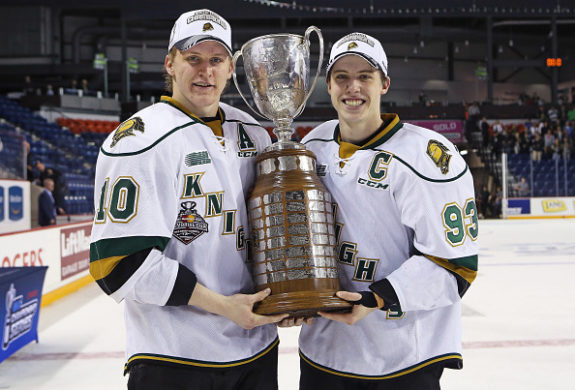
Below is the list of OHL champions since the 2004-05 London Knights rewrote the recipe for building a championship team. I’ve argued elsewhere that the 2004-05 season was the first year of the modern OHL. This definition might warrant a revisit, but I think it’s satisfactory for our purposes here. It’s an impressive group.
| Season | Team | Pts | Pts Rank | GD | GD Rank | CF% | CF% Rank |
| 2004-05 | London | 120 | 1 | 185 | 1 | 54.84 | 2 |
| 2005-06 | Peterborough | 99 | 2 | 72 | 3 | 50.69 | 8 |
| 2006-07 | Plymouth | 103 | 2 | 124 | 1 | 50.52 | 10 |
| 2007-08 | Kitchener | 110 | 1 | 118 | 1 | 61.81 | 1 |
| 2008-09 | Windsor | 115 | 1 | 138 | 1 | 60.82 | 1 |
| 2009-10 | Windsor | 106 | 2 | 129 | 2 | 61.63 | 1 |
| 2010-11 | Owen Sound | 97 | 2 | 70 | 4 | 54.16 | 3 |
| 2011-12 | London | 99 | 1 | 95 | 2 | 52.15 | 3 |
| 2012-13 | London | 105 | 1 | 95 | 1 | 53.16 | 5 |
| 2013-14 | Guelph | 108 | 1 | 149 | 1 | 54.55 | 5 |
| 2014-15 | Oshawa | 108 | 2 | 137 | 2 | 58.94 | 1 |
| 2015-16 | London | 105 | T1 | 138 | 1 | 55.09 | 3 |
| 2016-17 | Erie | 103 | 1 | 135 | 1 | 59.85 | 1 |
Devising an OHL Contention Metric
There’s a lot to unpack here. First, we see that regular season points correlate very highly with playoff success. In fact, every OHL champion in the modern era finished with a top-two regular season points total. If we wanted to, we could cut off our analysis by saying that top-two finishers are contenders and everyone else is an also-ran. But that feels unsatisfying and would omit some great teams from our list.
Moving to the other columns, we see that there’s also a pretty strong correlation between goal differential and championships, with just two teams, the 2005-06 Peterborough Petes and the 2010-11 Owen Sound Attack, finishing outside the top two in the league in their championship seasons, and none finishing outside the top four. Corsi is less highly correlated with playoff success, but it’s worth noting that every champion had a positive rating and all but two teams finished in the top five.
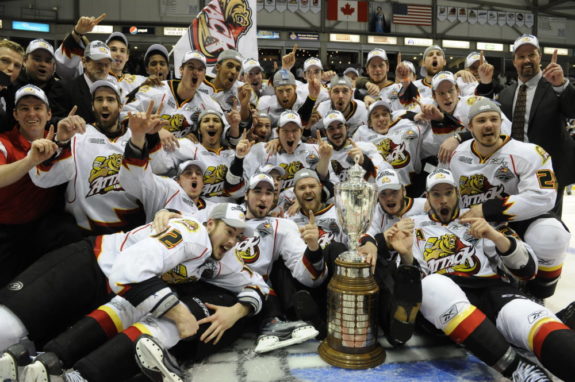
Those Petes and Attack teams are real outliers in terms of goal differential: a good 20-plus goals behind the 2011-12 and 2012-13 Knights and far behind the 130-plus GD squads that have won championships the past few years. They’re also notable as two of just three modern OHL champions (again with the 2011-12 Knights) to win the league with fewer than 103 regular season points.
Because most modern OHL champions have outpaced those teams considerably, it seems fair to consider the 2005-06 Petes and the 2010-11 Attack as forming a kind of lower bound for championship contention. The Attack’s 97 points and plus-70 GD are the lowest in the sample. Let’s use those values to establish a kind of “contention threshold” and examine which teams from 2004-05 on have reached both benchmarks.
Great Teams, Greater Heartbreak
The following teams put up a minimum of 97 points in the regular season and a goal differential of plus-70 or greater but did not win a championship.
| Season | Team | Pts | Pts Rank | GD | GD Rank | CF% | CF% Rank |
| 2005-06 | London | 102 | 1 | 91 | 1 | 50.93 | 6 |
| 2006-07 | London | 104 | 1 | 73 | T5 | 48.53 | 15 |
| 2006-07 | Kitchener | 98 | 3 | 75 | 3 | 58.47 | 1 |
| 2006-07 | Barrie | 97 | 4 | 74 | 4 | 58.08 | 8 |
| 2007-08 | Belleville | 102 | 2 | 105 | 2 | 51.90 | 7 |
| 2008-09 | London | 101 | 2 | 93 | 2 | 53.43 | 3 |
| 2008-09 | Belleville | 98 | 3 | 83 | 3 | 49.75 | 9 |
| 2009-10 | Barrie | 116 | 1 | 142 | 1 | 55.24 | 3 |
| 2010-11 | Mississauga | 108 | 1 | 115 | 1 | 59.68 | 1 |
| 2011-12 | Niagara | 97 | T2 | 123 | 1 | 58.65 | 2 |
| 2011-12 | Plymouth | 97 | T2 | 71 | 3 | 51.91 | 4 |
| 2013-14 | Erie | 106 | 2 | 140 | 2 | 56.34 | 2 |
| 2013-14 | London | 103 | 3 | 116 | 3 | 56.58 | 1 |
| 2014-15 | Sault Ste. Marie | 110 | 1 | 146 | 1 | 56.12 | 4 |
| 2014-15 | Erie | 104 | 3 | 117 | 3 | 56.60 | 3 |
| 2015-16 | Erie | 105 | T1 | 79 | 3 | 56.56 | 1 |
| 2016-17 | Owen Sound | 102 | 2 | 120 | 2 | 58.97 | 2 |
| 2016-17 | Sault Ste. Marie | 100 | 3 | 77 | 4 | 54.26 | 3 |
| 2016-17 | London | 99 | 4 | 97 | 3 | 50.84 | 8 |
Nineteen teams, and a who’s who of talented squads that came up short, from the 116-point 2009-10 Barrie Colts to the series of 50-win Erie Otters teams that experienced various degrees of playoff heartbreak before finally breaking through this past season.

There’s an obvious step down here from the previous group, championships aside: they averaged 3.5 fewer points and 20 fewer net goals. But they were dominant against non-champions in the playoffs, winning 37 of 40 series against them, excluding series against each other. Fourteen of the teams lost to the eventual champion. If we’re expanding our definition of “contender” beyond just the champions, this is a great group to start with.
Is this group enough? When you consider that no team with a lesser points total or lower goal differential has won the modern OHL, it seems like a reasonable cut-off. But it’s hard to shake the feeling that we’re missing some other excellent teams—and some thrilling playoff stories.
Who Are We Missing?
Five times in the modern OHL, the eventual champion has been pushed to seven games. Most recently, the Knights took the Otters to seven in their second-round series in April.
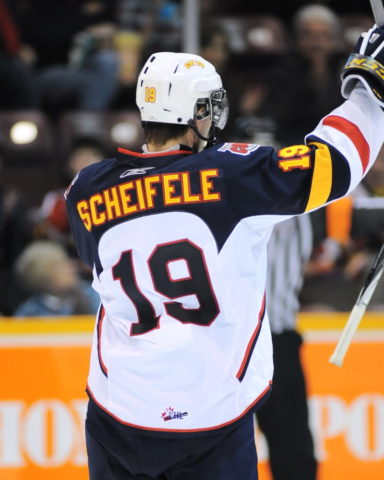
Three of those times, the opponent in question was one of the contenders above. (2007-08 Belleville and 2009-10 Mississauga are the others.) But the last two teams deserve mention as well. In the 2010 playoffs, the feisty Rangers opened up what is perhaps the most improbable 3-0 series lead in OHL history on the reigning Memorial Cup champion Windsor Spitfires. The Spitfires, of course, mounted a historic comeback to win the series, swept Barrie in the OHL Final, and went on to become the first back-to-back Memorial Cup winner since the early 90s. Three years later, the Knights executed their own heroic comeback, clawing back from a 3-1 deficit against the Barrie Colts.
Here’s the nitty-gritty on the Rangers and Colts:
| Season | Team | Pts | Pts Rank | GD | GD Rank | CF% | CF% Rank |
| 2009-10 | Kitchener | 91 | 4 | 50 | 4 | 50.37 | 8 |
| 2012-13 | Barrie | 92 | 5 | 56 | 5 | 48.21 | 12 |
Finally, the unique format of the Memorial Cup gives us the occasional champion that didn’t win its own league. The 2016-17 Spitfires are the only team in the modern OHL to pull off the feat, but excluding them after their dominant Cup performance seems foolish.
| Season | Team | Pts | Pts Rank | GD | GD Rank | CF% | CF% Rank |
| 2016-17 | Windsor | 90 | 5 | 49 | 5 | 50.42 | 9 |
By our relevant statistical measures, the three teams are almost identical—90-ish points, approximately 50 more goals than their opponents on the season, and middling Corsi ratings.
The Fringe OHL Contenders
Using the 90-point, plus-49 GD Spitfires as a baseline, we can sketch out another level of contention below our previously established threshold. Let’s call this group the ‘fringe contenders.’
| Season | Team | Pts | Pts Rank | GD | GD Rank | CF% | CF% Rank |
| 2004-05 | Owen Sound | 90 | 2 | 58 | 2 | 58.75 | 1 |
| 2005-06 | Kitchener | 96 | 3 | 90 | 2 | 56.38 | 1 |
| 2005-06 | Brampton | 91 | 4 | 50 | 5 | 50.89 | 7 |
| 2005-06 | Barrie | 90 | 5 | 65 | 4 | 54.08 | 3 |
| 2006-07 | Saginaw | 91 | 5 | 73 | T5 | 54.90 | 3 |
| 2006-07 | Mississauga | 90 | 6 | 77 | 2 | 54.23 | 4 |
| 2007-08 | Sault Ste. Marie | 94 | T3 | 76 | 4 | 54.70 | 4 |
| 2007-08 | Windsor | 94 | T3 | 77 | 3 | 58.00 | 2 |
| 2008-09 | Brampton | 96 | 4 | 79 | 4 | 59.10 | 2 |
| 2009-10 | London | 101 | 3 | 62 | 3 | 52.94 | 4 |
| 2009-10 | Kitchener | 91 | 4 | 50 | 4 | 50.37 | 8 |
| 2010-11 | Niagara | 96 | 3 | 76 | 3 | 53.58 | 4 |
| 2010-11 | Ottawa | 93 | 4 | 77 | 2 | 48.69 | 12 |
| 2012-13 | Belleville | 96 | 2 | 58 | 4 | 57.51 | 7 |
| 2012-13 | Owen Sound | 94 | 3 | 66 | 3 | 58.55 | 8 |
| 2012-13 | Plymouth | 93 | 4 | 93 | 2 | 56.53 | 2 |
| 2012-13 | Barrie | 92 | 5 | 56 | 5 | 48.21 | 14 |
| 2013-14 | Sault Ste. Marie | 95 | 4 | 69 | 4 | 52.35 | 7 |
| 2015-16 | Kingston | 97 | 3 | 60 | T5 | 54.74 | T4 |
| 2015-16 | Kitchener | 95 | 4 | 60 | T5 | 55.41 | 2 |
| 2015-16 | Sarnia | 91 | 5 | 62 | 4 | 54.74 | T4 |
| 2016-17 | Windsor | 90 | 5 | 49 | 5 | 50.42 | 9 |
It’s a big list, with a big spread in team quality, and it points to how imprecise this work can be. There are some great, memorable teams on that list, such as the John Tavares-led 2008-09 Knights, who pushed the Spitfires to five straight overtime games in the 2009 playoffs. But there are also some notable flameouts. The 2005-06 Rangers were ousted in five games by an Attack team that attempted to deliberately lose a game to avoid playing them, while the 2015-16 Sarnia Sting lost their opening round series to a seventh-seeded Greyhounds team after adding aggressively at the trade deadline.
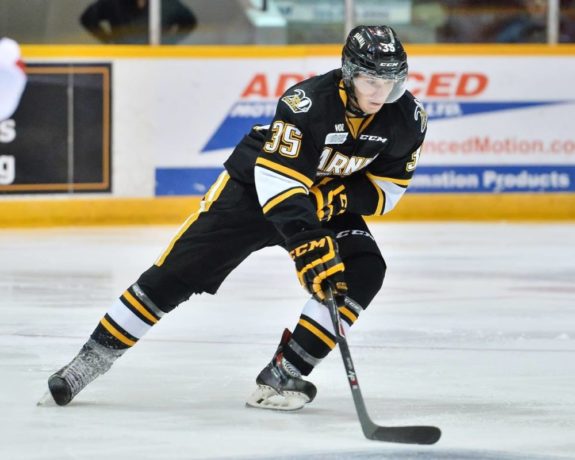
Which Model Do We Prefer?
Do the fringe contenders belong with the more robust teams we identified earlier?
In a word, no. More than a third of the fringe contenders lost to non-contenders (i.e. sub-90-point and/or sub-49 GD teams), and the fringe contenders were a collective 1-10 against our list of contenders, with the one win by the 2008-09 Brampton Battalion (96 points, plus-79 GD) against the Belleville Bulls (98 points, plus-83 GD)—statistically indistinguishable teams, at least by our metrics. And while teams like the Battalion probably deserve better than “fringe contender” status, the Battalion would have been the weakest OHL champion by points since 2002, and ultimately bowed out meekly to the powerhouse Spitfires in five games in the OHL Final, getting outscored by 13 goals.
Dropping the points requirement to 95 or 96 to accommodate teams like the Battalion or letting in high GD teams that missed the points threshold would drag in a fair bit of chaff with the wheat. Ultimately, I think our first group of contenders is a good one. The teams put marks in the W column while dominating the scorer’s sheet, and they’re statistically similar to the teams that have won the league in the past. As for the fringe contenders, they’re probably best thought of as exactly that: fringe contenders, or longshots. The next fringe contender to win the league will be the first in the modern OHL. With a manageable playoff path and a few lucky breaks, it could happen. I just wouldn’t bet on it.
It turns out that the 2015-16 Rangers, with their 95 points and plus-60 goal differential, are just such a fringe contender. So as far as this analysis is concerned, those Rangers fans were right, and I was wrong—their team was not a legitimate contender two seasons ago.
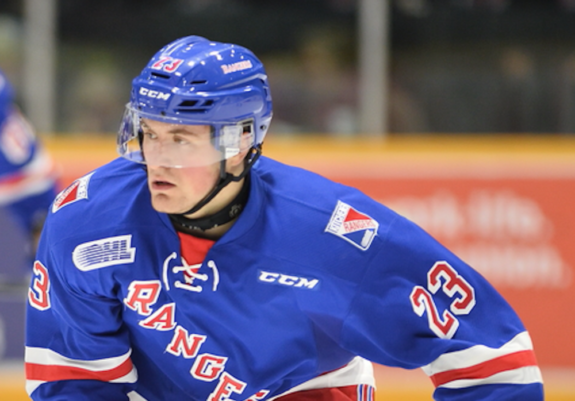
Over the next few months, we’ll take a further dive into contention metrics and what they can tell us about the league, from which OHL seasons have been the most exciting to which OHL fanbases are the most long-suffering. I’ll also check in around the midpoint of the season to see which teams are shaping up as 2017-18’s championship contenders, fringe contenders, and also-rans.